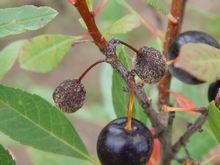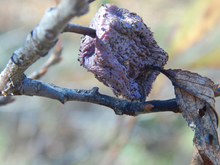Quick facts
- Brown rot is the most serious disease in plums, tart cherries and apricots in Minnesota.
- This disease damages shoots, twigs and fruit.
- During ripening and in storage after harvest, brown rot can spread quickly from one fruit to another until most of the fruit are inedible.
- Twig blight caused by brown rot is very common in apricot trees.
- Manage this disease by keeping your orchard clean and pruning out diseased wood.
How to identify brown rot
Flower symptoms
- In spring, some blossoms turn brown and die.
- Blossoms that die from brown rot usually stay attached to the branch with a sticky gum like droplet. In contrast, blossoms killed by frost fall to the ground.
Twig and branch symptoms
- The infection can move from the infected flower to the spur (short branch) holding the flower and into branch below the blossom, causing a canker in the branch.
- Twig cankers have discolored bark and often have drops of sticky gum between the diseased and healthy area of the branch.
- When these cankers encircle the twig, all leaves beyond the canker turn brown and wilt. These leaves remain attached to the branch.
- During wet weather, small tan-to-gray powdery clumps of spores may form on infected twigs and cankers.
- Apricot is most likely to be affected by twig blight in Minnesota.
Fruit symptoms
- A small, firm, brown spot appears on ripe or ripening fruit.
- This spot quickly grows to encompass large portions of the fruit.
- Infected fruit stay attached to the tree.
- With time, these fruit become dry and shriveled.
- Shriveled fruit may stay attached to the tree well into the next growing season.
- Tan-to-gray, powdery clumps of spores appear on rotten and shriveled fruit during wet weather.
How does brown rot survive and spread?
- Brown rot is caused by the fungi Monolinia fructicola and Monolinia laxa.
- Brown rot fungi overwinter in shriveled fruit, infected twigs and branches.
- The primary source of spores in the spring is shriveled fruit on the trees or on the ground.
- In the spring, the fungus starts growing under cool, wet conditions and produces spores.
- Spores are spread to the blossoms by the wind or rain.
- The flowers must stay wet for several hours for the infection to start.
- The length of time the flowers must stay wet depends on the temperature.
- At 70 F, the blossom only needs to be wet for 3 hours for the infection to occur.
- At 45 F, the blossom must be wet for at least 6 hours for an infection to occur.
- The infection often spreads from the blossom through the stem and into the bark, where a small canker can form beneath the dead flower.
- Fungi in these cankers can then produce secondary spores for much of the summer.
- The disease spreads slowly in early summer. Developing fruit isn’t likely to be infected unless it’s been damaged by insects, hail or stem rub.
- As the fruits ripen and change color, they become more likely to be infected.
- Infected fruit produce many fluffy, tan-to-gray spores that can easily spread to other fruit on the same tree and other trees.
- Once one ripe fruit is infected, then the infection can spread to neighboring fruit until all the fruit in a cluster are infected.
How to manage brown rot
Keep your orchard clean
- Before bud break in early spring, remove all shriveled fruit that is still on the trees.
- Keep the area around the trees clean of fallen fruit and other plant debris. This will lower the number of spores produced in the orchard and make brown rot easier to manage.
- Pick up all fallen fruit during the summer.
- Harvest all fruit as it ripens. Bury infected or over ripe fruit in a compost pile.
Prune out diseased wood
- Cut out all branches with cankers and remove all twigs that have died from brown rot in February or March.
Fungicides
First, keep your orchard clean and prune disease wood out of your tree. If you’ve done this and have still had severe twig blight or fruit rot in previous years, you might consider using a fungicide to protect your tree.
- Fungicides must be applied at two specific times to protect different plant parts.
- To protect trees from blossom blight and twig blight, begin fungicide applications when blossoms first begin to open. Repeat sprays according to label instructions until petal fall.
- To protect trees from fruit rot, begin fungicide sprays 2 to 3 weeks prior to harvest as fruit is ripening. Repeat sprays according to label instructions until harvest.
- Fungicides don’t need to be applied to green fruit. These immature fruit are not likely to be infected.
- Fungicides always work best when combined with sanitation.
Fungicides for brown rot
- Myclobutanil
- Propiconazole
- Chlorothalonil - Do not use for fruit rot control. Apply only for blossom blight.
- Captan
- Sulfur - Some formulations acceptable in organic agriculture.
CAUTION: Mention of a pesticide or use of a pesticide label is for educational purposes only. Always follow the pesticide label directions attached to the pesticide container you are using. Be sure that the plant you wish to treat is listed on the label of the pesticide you intend to use. And observe the number of days between pesticide application and when you can harvest your crop. Remember, the label is the law.
Reviewed in 2024




